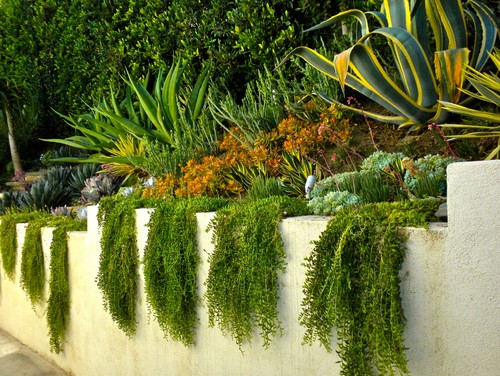Landscape retaining walls are generally used on sloped terrain where it is not possible a re-grade of this terrain. A re-grading will save you a lot of money but it is not always, possible. However, you should take in consideration this option, if it is possible. Sometimes a combination of retaining walls and re-grading can work pretty well and the cost of a such combined project will be lower than a higher retaining wall.

Photo by Jilzart Design – Look for landscaping pictures
But back to our subject.
A landscape retaining wall can be made from different kind of materials, such as bricks, decorative blocks or natural stones. Of course, the materials used and the length and height of this wall will dictate the price.
You can set large boulders among other rocks to create a wall with a great aesthetic look.
Where You Can Use a Retaining Wall
Usually, a landscape retaining to construct a level area and can be useful in many situations, such as:
a) You can use a landscape retaining for pool surrounding area, a patio or other different outdoor spaces.
b) You can use a landscape retaining wall as a playground for your children.
c) You can use a landscape retaining wall to build wonderful flat terraced gardens for your plants.
d) A retaining wall will cut the slope of your landscape for a much easier mowing.
e) A landscape retaining walls will facilitate access to different areas of your outdoor property.
Landscape Retaining Wall Guidelines
a) Landscape Slope
It is recommended that a landscape slope not to be more than 3:1 or 33%. That means for a length=3 feet, the height has to be less than one feet. These reports will determine if you need one or more retaining walls. Depending on the nature of the terrain you may need a tall retaining wall or several lower.
b) Planted Area
Leave enough room between the walls and planted area. This will protect your walls.
c) Retaining Wall Safety
To prevent your children to climb these walls and fall over, plant evergreen shrubs on top of them. You can use Japanese Holly, Rhododendron, Cherry Laurel or Boxwood.
Retaining Wall Materials
As I have mentioned above there are different materials that you can incorporate into your wall, such as:
a) Bricks – A landscape retaining wall made of bricks is a relatively an expensive wall. However, wall is essentially made of concrete blocks and the bricks are mortared to it. It can be a great seat wall or it can have a bluestone cap.
b) Decorative Concrete Blocks – this is maybe the less expensive choice for a landscape retaining wall. You can build your wall in a unique color or you can use different colored concrete blocks.
c) Dry Laid Stones – This is the most traditional retaining wall. There is a wide range of natural stones. The trick is to place the landscape boulders at the ends of the walls or to mix them with smaller stones.
d) Mortared Stones – This is the most expensive type of landscape retaining wall. You need to use natural and different sizes of stones. The wall will be clad with thin stones mortared to wall.
e) Concrete – Concrete is a maybe less expensive, but it is inferior to the other types of walls and is prone to cracking over time.
How to Share Your Outdoor Spaces with Insect Life | How To Build A House (howtobuildahouseblog.com)


